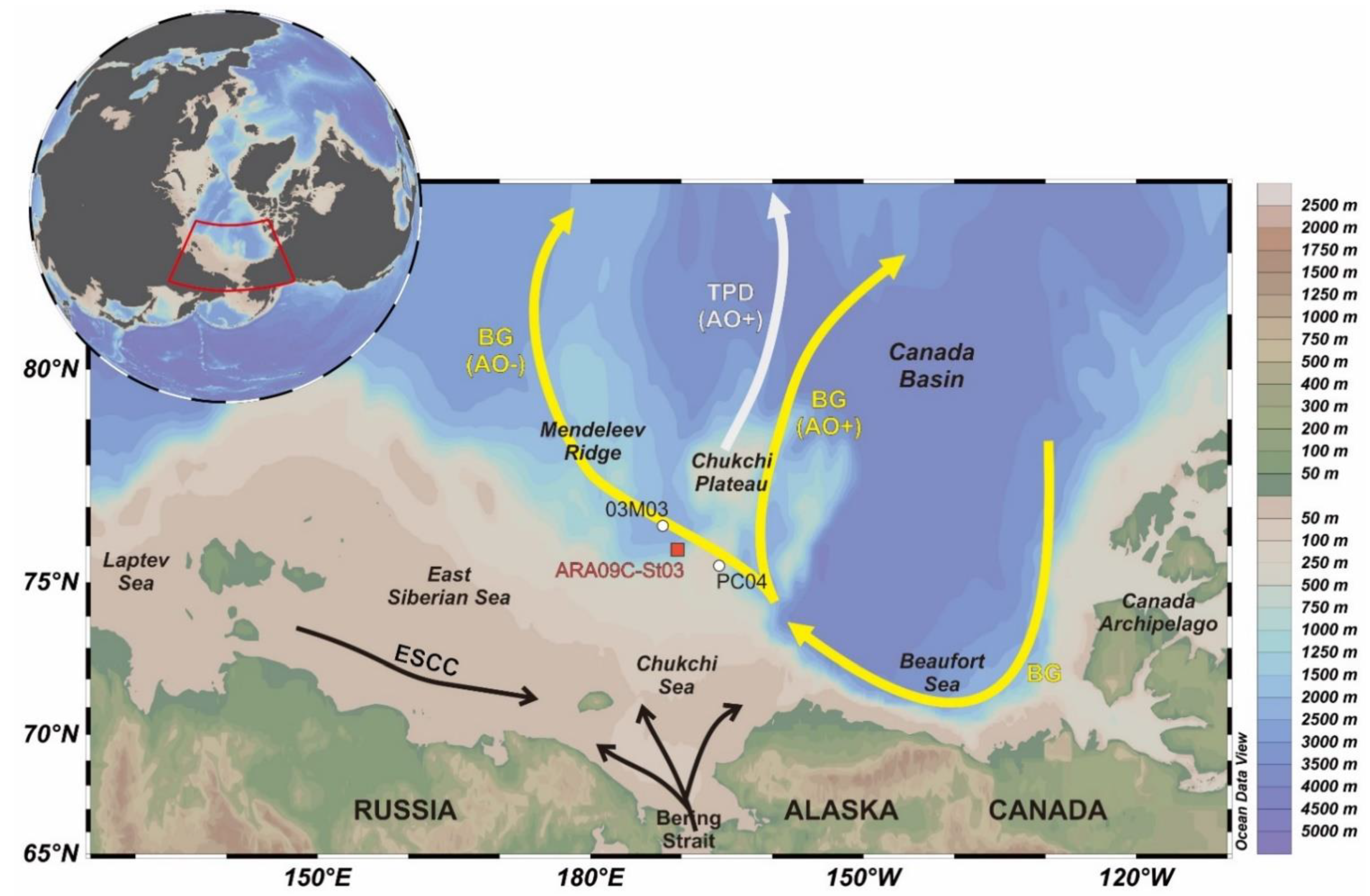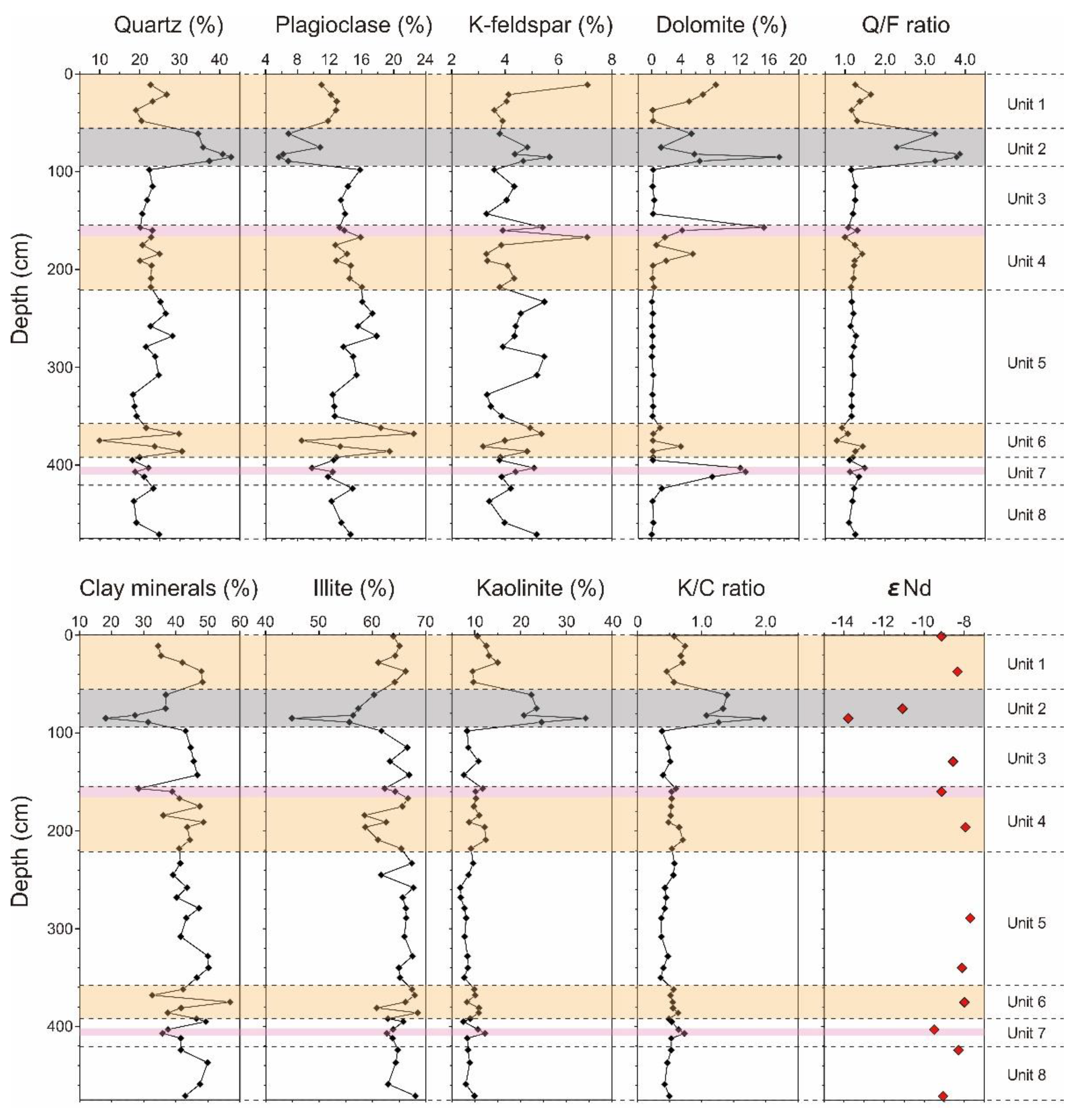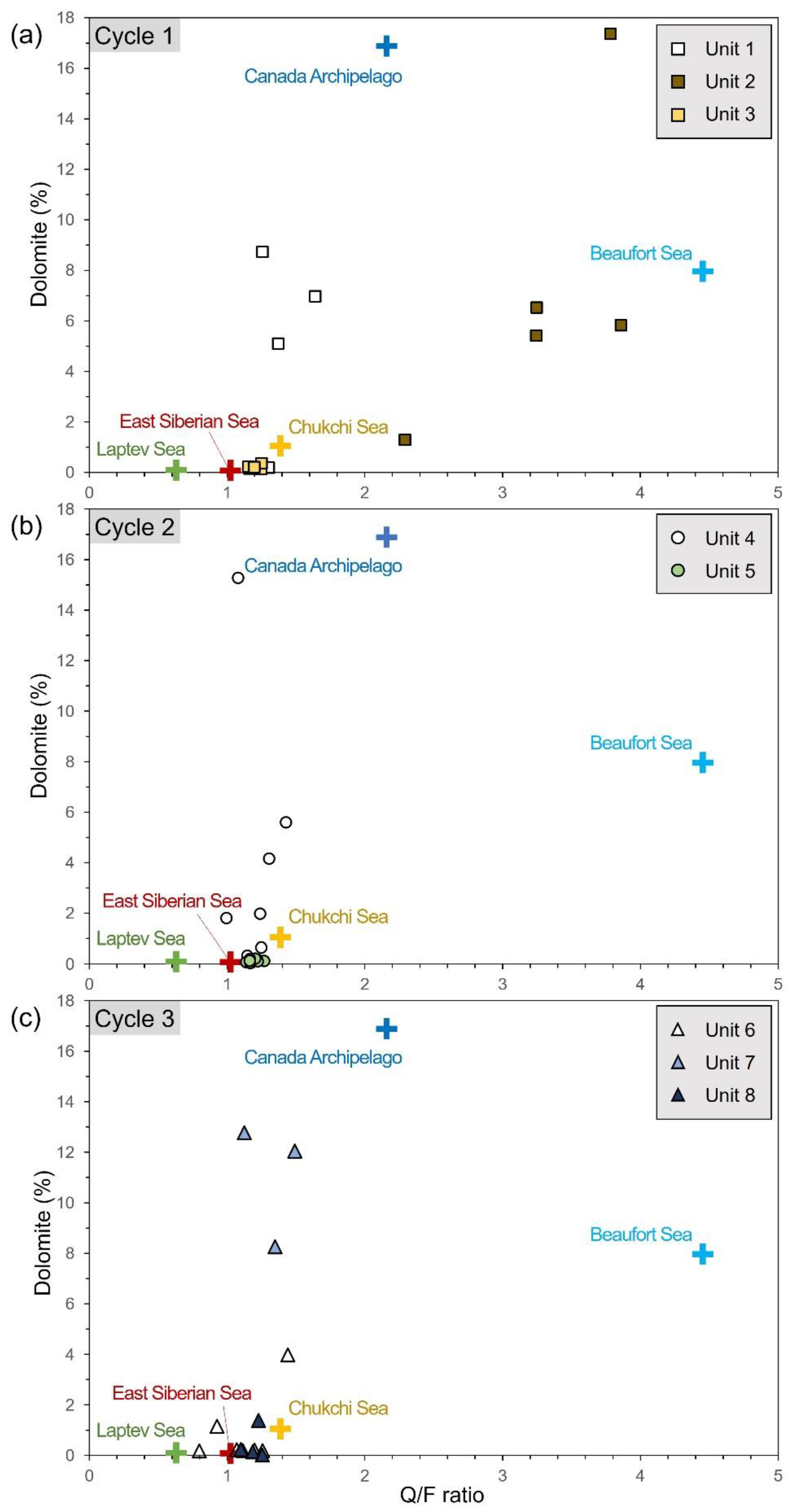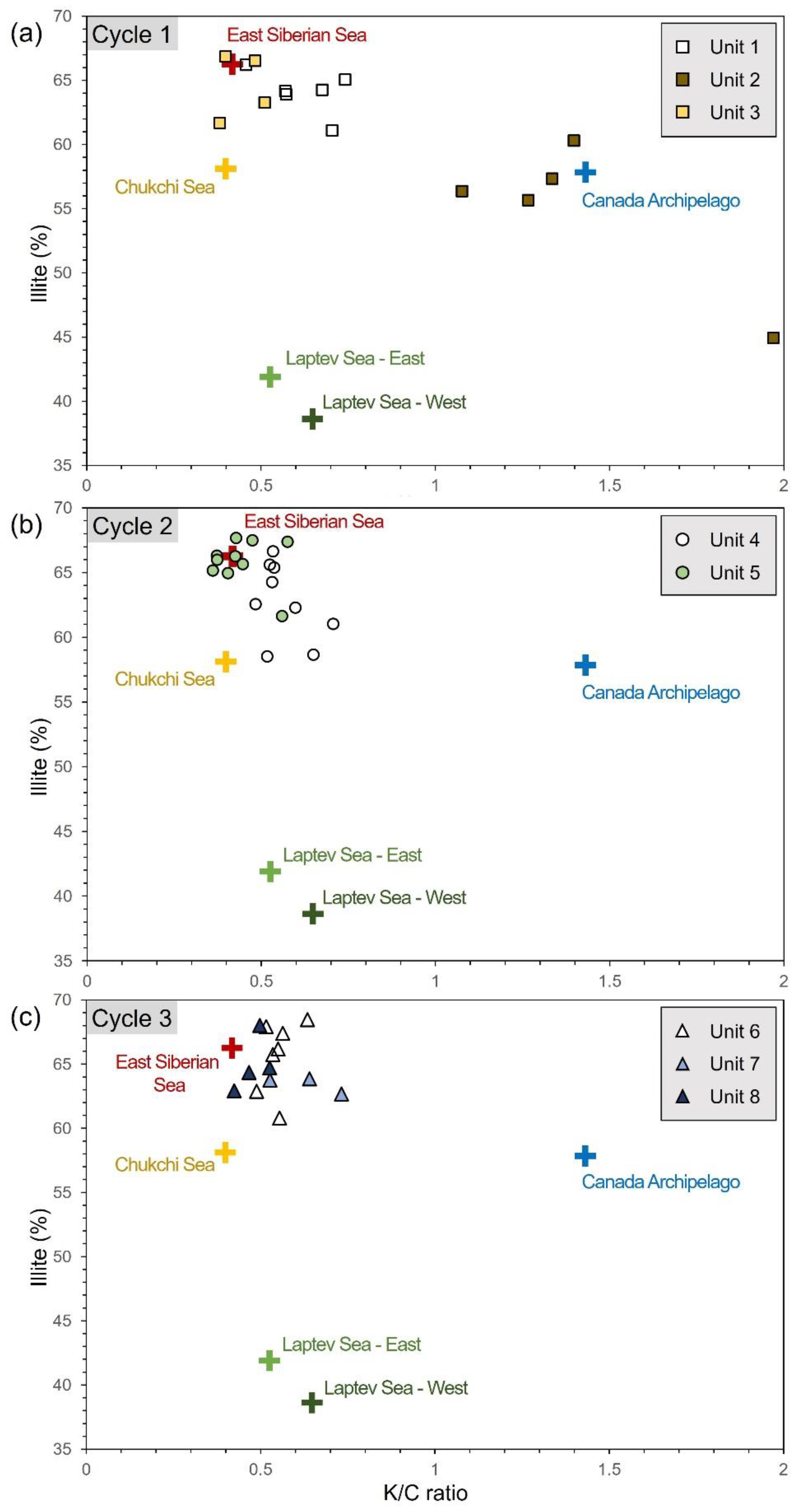Change in Sediment Provenance on the Inner Slope of the Chukchi Rise and Their Paleoenvironmental Implications
Abstract
:1. Introduction
2. Materials and Methods
3. Results
4. Discussion
4.1. Age Assignment
4.2. Provenance Discrimination
4.3. Paleoenvironmental Implication for Sediment Provenance Changes
5. Conclusions
Supplementary Materials
Author Contributions
Funding
Institutional Review Board Statement
Informed Consent Statement
Data Availability Statement
Conflicts of Interest
References
- Jakobsson, M.; Macnab, R.; Mayer, L.; Anderson, R.M.; Edwards, M.; Hatzky, J.; Schenke, H.W.; Johnson, P. An improved bathymetric portrayal of the Arctic Ocean: Implications for ocean modeling and geological, geophysical and oceanographic analyses. Geophys. Res. Lett. 2008, 35, 7602. [Google Scholar] [CrossRef] [Green Version]
- Stein, R. Arctic Ocean Sediments: Processes, Proxies, and Paleoenvironment: Processes, Proxies, and Paleoenvironment; Elsevier: Amsterdam, The Netherlands, 2008; pp. 1–608. [Google Scholar]
- Stein, R.; Boucsein, B.; Fahl, K.; Garcia de Oteyza, T.; Knies, J.; Niessen, F. Accumulation of particulate organic carbon at the Eurasian continental margin during late Quaternary times: Controlling mechanisms and paleoenvironmental signifi-cance. Glob. Planet. Chang. 2001, 31, 87–104. [Google Scholar] [CrossRef]
- Jakobsson, M.; Grantz, A.; Kristoffersen, Y.; Macnab, R. Physiographic provinces of the Arctic Ocean seafloor. Geol. Soc. Am. Bull. 2003, 115, 1443–1455. [Google Scholar] [CrossRef]
- Rachold, V.; Eicken, H.; Gordeev, V.; Grigoriev, M.N.; Hubberten, H.-W.; Lisitzin, A.P.; Shevchenko, V.P.; Schirrmeister, L. Modern Terrigenous Organic Carbon Input to the Arctic Ocean, The Organic Carbon Cycle in the Arctic Ocean; Springer: Berlin/Heidelberg, Germany, 2004; pp. 33–55. [Google Scholar]
- Grigoriev, M.N.; Rachold, V.; Schirrmeister, L.; Hubberten, H.-W. Organic Carbon Input to the Arctic Seas through Coastal Erosion; Springer: Berlin/Heidelberg, Germany, 2004; pp. 41–45. [Google Scholar]
- Stein, R.; Matthiessen, J.; Niessen, F.; Krylov, A.; Nam, S.; Bazhenova, E. Towards a better (litho-) stratigraphy and reconstruction of Quaternary paleoenvironment in the Amerasian Basin (Arctic Ocean). Polarforschung 2010, 79, 97–121. [Google Scholar]
- Zou, H. An X-Ray Diffraction Approach: Bulk Mineral Assemblages as Provenance Indicator of Sediments from the Arctic Ocean. Ph.D. Thesis, University of Bremen, Bremen, Germany, 15 June 2016. [Google Scholar]
- Dong, L.; Liu, Y.; Shi, X.; Polyak, L.; Huang, Y.; Fang, X.; Liu, J.; Zou, J.; Wang, K.; Sun, F.; et al. Sedimentary record from the Canada Basin, Arctic Ocean: Implications for late to middle Pleistocene glacial history. Clim. Past 2017, 13, 511–531. [Google Scholar] [CrossRef] [Green Version]
- Myers, W.B. Circum-Arctic Mineralogy & Pan-Arctic Chronostratigraphy of Late Pleistocene Sediments: Developing a Comprehensive Age Model for the Western Arctic Ocean Using Unique Ice-Rafted Signals. Ph.D. Thesis, Old Dominion University, Norfolk, VA, USA, December 2019. [Google Scholar]
- Darby, D.A.; Ortiz, J.D.; Grosch, C.E.; Lund, S.P. 1,500-year cycle in the Arctic Oscillation identified in Holocene Arctic sea-ice drift. Nat. Geosci. 2012, 5, 897–900. [Google Scholar] [CrossRef]
- Proshutinsky, A.; Johnson, M.A. Two circulation regimes of the wind-driven Arctic Ocean. J. Geophys. Res. Space Phys. 1997, 102, 12493–12514. [Google Scholar] [CrossRef]
- Tremblay, L.-B.; Mysak, L.A.; Dyke, A.S.; Tremblay, L.-B.; Mysak, L.A.; Dyke, A.S. Evidence from driftwood records for century-to-millennial scale variations of the high latitude atmospheric circulation during the Holocene. Geophys. Res. Lett. 1997, 24, 2027–2030. [Google Scholar] [CrossRef] [Green Version]
- Darby, D.A.; Bischof, J.F. A Holocene Record of Changing Arctic Ocean Ice Drift Analogous to the Effects of the Arctic Os-cillation. Paleoceanogr. Paleoclimatol. 2004, 19, 1–9. [Google Scholar]
- Naidu, A.S.; Mowatt, T.C. Sources and dispersal patterns of clay minerals in surface sediments from the continental-shelf areas off Alaska. Geol. Soc. Am. Bull. 1983, 94, 841–854. [Google Scholar] [CrossRef]
- Weingartner, T.; Aagaard, K.; Woodgate, R.; Danielson, S.; Sasaki, Y.; Cavalieri, D. Circulation on the north central Chukchi Sea shelf. Deep. Sea Res. Part II Top. Stud. Oceanogr. 2005, 52, 3150–3174. [Google Scholar] [CrossRef]
- Kobayashi, D.; Yamamoto, M.; Irino, T.; Nam, S.-I.; Park, Y.-H.; Harada, N.; Nagashima, K.; Chikita, K.; Saitoh, S.-I. Distribution of detrital minerals and sediment color in western Arctic Ocean and northern Bering Sea sediments: Changes in the provenance of western Arctic Ocean sediments since the last glacial period. Polar Sci. 2016, 10, 519–531. [Google Scholar] [CrossRef]
- Darby, D.A.; Myers, W.B.; Jakobsson, M.; Rigor, I. Modern dirty sea ice characteristics and sources: The role of anchor ice. J. Geophys. Res. Space Phys. 2011, 116, 1–18. [Google Scholar] [CrossRef] [Green Version]
- Naidu, A.; Creager, J.; Mowatt, T. Clay mineral dispersal patterns in the north Bering and Chukchi Seas. Mar. Geol. 1982, 47, 1–15. [Google Scholar] [CrossRef]
- Viscosi-Shirley, C.; Mammone, K.; Pisias, N.; Dymond, J.; Viscosi-Shirley, C.; Mammone, K.; Pisias, N.; Dymond, J. Clay mineralogy and multi-element chemistry of surface sediments on the Siberian-Arctic shelf: Implications for sediment provenance and grain size sorting. Cont. Shelf Res. 2003, 23, 1175–1200. [Google Scholar] [CrossRef]
- Park, K.; Ohkushi, K.I.; Cho, H.G.; Khim, B.K. Lithostratigraphy and paleoceanography in the Chukchi Rise of the western Arctic Ocean since the last glacial period. Polar Sci. 2017, 11, 42–53. [Google Scholar] [CrossRef]
- Vogt, C.; Knies, J. Sediment dynamics in the Eurasian Arctic Ocean during the last deglaciation—The clay mineral group smectite perspective. Mar. Geol. 2008, 250, 211–222. [Google Scholar] [CrossRef]
- Wang, R.; Xiao, W.; März, C.; Li, Q. Late Quaternary paleoenvironmental changes revealed by multi-proxy records from the Chukchi Abyssal Plain, western Arctic Ocean. Glob. Planet. Chang. 2013, 108, 100–118. [Google Scholar] [CrossRef]
- Wahsner, M.; Muller, C.; Stein, R.; Ivanov, G.; Levitan, M.; Shelekova, E.; Tarasov, G. Clay mineral distributions in surface sediments from the Central Arctic Ocean and the Eurasian continental margin as indicator for source areas and transport pathways: A synthesis. Boreas 1999, 28, 215–233. [Google Scholar] [CrossRef]
- Fagel, N.; Not, C.; Gueibe, J.; Mattielli, N.; Bazhenova, E. Late Quaternary evolution of sediment provenances in the Central Arctic Ocean: Mineral assemblage, trace element composition and Nd and Pb isotope fingerprints of detrital fraction from the Northern Mendeleev Ridge. Quat. Sci. Rev. 2014, 92, 140–154. [Google Scholar] [CrossRef]
- Polyak, L.; Bischof, J.; Ortiz, J.D.; Darby, D.A.; Channell, J.E.; Xuan, C.; Adler, R.E. Late Quaternary stratigraphy and sedimentation patterns in the western Arctic Ocean. Glob. Planet. Chang. 2009, 68, 5–17. [Google Scholar] [CrossRef]
- Schreck, M.; Nam, S.-I.; Polyak, L.; Vogt, C.; Kong, G.-S.; Stein, R.; Matthiessen, J.; Niessen, F. Improved Pleistocene sediment stratigraphy and paleoenvironmental implications for the western Arctic Ocean off the East Siberian and Chukchi margins. Arktos 2018, 4, 21. [Google Scholar] [CrossRef]
- Biscaye, P.E. Mineralogy and Sedimentation of Recent Deep-Sea Clay in the Atlantic Ocean and Adjacent Seas and Oceans. Geol. Soc. Am. Bull. 1965, 76, 803–832. [Google Scholar] [CrossRef]
- Cheong, C.-S.; Ryu, J.-S.; Jeong, Y.-J. Simultaneous multiple collector-ICP-MS measurement of Nd isotopic composition and Sm/Nd ratio in geological reference materials by interference corrections and external calibration using matrix-matched standards. Geosci. J. 2013, 17, 389–395. [Google Scholar] [CrossRef]
- März, C.; Stratmann, A.; Matthiessen, J.; Meinhardt, A.-K.; Eckert, S.; Schnetger, B.; Vogt, C.; Stein, R.; Brumsack, H.-J. Manganese-rich brown layers in Arctic Ocean sediments: Composition, formation mechanisms, and diagenetic overprint. Geochim. Cosmochim. Acta 2011, 75, 7668–7687. [Google Scholar] [CrossRef]
- Macdonald, R.W.; Gobeil, C. Manganese Sources and Sinks in the Arctic Ocean with Reference to Periodic Enrichments in Basin Sediments. Aquat. Geochem. 2012, 18, 565–591. [Google Scholar] [CrossRef]
- Adler, R.E.; Polyak, L.; Ortiz, J.; Kaufman, D.S.; Channell, J.E.; Xuan, C.; Grottoli, A.G.; Sellén, E.; Crawford, K.A. Sediment record from the western Arctic Ocean with an improved Late Quaternary age resolution: HOTRAX core HLY0503-8JPC, Mendeleev Ridge. Glob. Planet. Chang. 2009, 68, 18–29. [Google Scholar] [CrossRef]
- Backman, J.; Fornaciari, E.; Rio, D. Biochronology and paleoceanography of late Pleistocene and Holocene calcareous nannofossil abundances across the Arctic Basin. Mar. Micropaleontol. 2009, 72, 86–98. [Google Scholar] [CrossRef]
- Darby, D.A. Sources of sediment found in sea ice from the western Arctic Ocean, new insights into processes of entrainment and drift patterns. J. Geophys. Res. Space Phys. 2003, 108, 3257. [Google Scholar] [CrossRef] [Green Version]
- Okulitch, A.V. Geology of the Canadian Archipelago and North Greenland. In Innuitian Orogen and Arctic Platform: Canada and Greenland, 1:200,000; Trettiln, H.P., Ed.; The Geology of North America, The Geological Society of America: Boulder, CO, USA, 1991. [Google Scholar]
- Darby, D.A.; Polyak, L.; Bauch, H.A. Past glacial and interglacial conditions in the Arctic Ocean and marginal seas-a re-view. Prog. Oceanogr. 2006, 71, 129–144. [Google Scholar] [CrossRef]
- Kilfeather, A.A.; Cofaigh, C.O.; Lloyd, J.M.; Dowdeswell, J.A.; Xu, S.; Moreton, S. Ice-Stream retreat and ice-shelf history in Marguerite Trough, Antarctic Peninsula: Sedimentological and foraminiferal signatures. Geol. Soc. Am. Bull. 2011, 123, 997–1015. [Google Scholar] [CrossRef]
- Bischof, J.F.; Darby, D.A. Mid- to Late Pleistocene Ice Drift in the Western Arctic Ocean: Evidence for a Different Circu-lation in the Past. Science 1997, 277, 74–78. [Google Scholar] [CrossRef]
- Simon, Q.; Hillaire-Marcel, C.; St-Onge, G.; Andrews, J.T. North-eastern Laurentide, western Greenland and southern Innuitian ice stream dynamics during the last glacial cycle. J. Quat. Sci. 2013, 29, 14–26. [Google Scholar] [CrossRef]
- Mueller-Lupp, T.; Bauch, H.A.; Erlenkeuser, H.; Hefter, J.; Kassens, H.; Thiede, J. Changes in the deposition of terrestrial organic matter on the Laptev Sea shelf during the Holocene: Evidence from stable carbon isotopes. Int. J. Earth Sci. 2000, 89, 563–568. [Google Scholar] [CrossRef] [Green Version]
- Andrews, J.; MacLean, B.; Kerwin, M.; Manley, W.; Jennings, A.; Hall, F. Final stages in the collapse of the laurentide ice sheet, Hudson Strait, Canada, NWT: 14C AMS dates, seismics stratigraphy, and magnetic susceptibility logs. Quat. Sci. Rev. 1995, 14, 983–1004. [Google Scholar] [CrossRef]





| Samples | n * | Quartz | K-Feldspar | Plagioclase | Dolomite | Mica | Clay Minerals | Q/F ** | Sand (>64 μm) | n of IRD *** (>250 μm) | |
|---|---|---|---|---|---|---|---|---|---|---|---|
| ARA09C-St03 | Unit 1 | 5 | 22.4 | 4.6 | 12.1 | 4.2 | 12.6 | 41.6 | 1.3 | 1.3 | 76 |
| Unit 2 | 5 | 38.2 | 4.7 | 7.3 | 7.3 | 10.2 | 30.1 | 3.2 | 13.2 | 956 | |
| Unit 3 | 4 | 22.0 | 3.8 | 14.3 | 0.2 | 11.8 | 45.0 | 1.2 | 0.2 | 10 | |
| Unit 4 | 9 | 22.2 | 4.3 | 14.2 | 3.3 | 11.5 | 41.1 | 1.2 | 4.3 | 287 | |
| Unit 5 | 10 | 22.9 | 4.4 | 14.8 | 0.1 | 11.3 | 44.3 | 1.2 | 0.1 | 0 | |
| Unit 6 | 7 | 21.9 | 4.3 | 15.3 | 0.9 | 11.5 | 43.8 | 1.1 | 0.3 | 10 | |
| Unit 7 | 3 | 20.7 | 4.4 | 11.3 | 11.0 | 12.1 | 38.3 | 1.3 | 6.1 | 362 | |
| Unit 8 | 4 | 21.5 | 4.2 | 13.8 | 0.4 | 12.5 | 45.5 | 1.2 | 0.3 | 9 | |
| Laptev Sea | 1 | 23.6 | 16.3 | 21.1 | 0.1 | 7.3 | 28.8 | 0.6 | - | - | |
| East Siberian Sea | 5 | 27.1 | 9.2 | 17.3 | 0.1 | 14.9 | 31.1 | 1.0 | - | - | |
| Chukchi Sea | 4 | 28.5 | 5.5 | 15.1 | 1.1 | 17.3 | 31.1 | 1.4 | - | - | |
| Canada Archipelago | 7 | 21.8 | 3.7 | 6.4 | 16.9 | 14.2 | 31.4 | 2.2 | - | - | |
| Beaufort Sea | 3 | 39.3 | 3.7 | 5.1 | 8.0 | 10.2 | 25.4 | 4.5 | - | - | |
| Bering Strait | 1 | 31.4 | 14.0 | 18.3 | 0.2 | 14.4 | 19.2 | 1.0 | - | - | |
| Samples | n * | Illite | Chlorite | Kaolinite | Smectite | K/C ** | Reference | |
|---|---|---|---|---|---|---|---|---|
| ARA09C-St03 | Unit 1 | 6 | 64.1 | 19.0 | 11.8 | 5.1 | 0.6 | This study |
| Unit 2 | 5 | 54.9 | 17.9 | 25.1 | 2.1 | 1.4 | ||
| Unit 3 | 4 | 64.6 | 20.0 | 8.8 | 6.6 | 0.4 | ||
| Unit 4 | 9 | 62.8 | 18.9 | 10.6 | 7.8 | 0.6 | ||
| Unit 5 | 10 | 65.8 | 18.5 | 8.0 | 7.6 | 0.4 | ||
| Unit 6 | 7 | 65.6 | 17.4 | 9.5 | 7.5 | 0.5 | ||
| Unit 7 | 3 | 63.4 | 16.5 | 10.4 | 9.7 | 0.6 | ||
| Unit 8 | 4 | 65.0 | 18.6 | 8.9 | 7.5 | 0.5 | ||
| Laptev Sea—west | 48/64 | 38.6 | 22.5 | 14.5 | 24.4 | 0.6 | [16,24] | |
| Laptev Sea—east | 35/96 | 41.9 | 22.2 | 11.7 | 24.3 | 0.5 | ||
| East Siberian Sea | 20/84 | 66.3 | 19.9 | 8.3 | 5.9 | 0.4 | [16,24] | |
| Chukchi Sea | 17/8 | 58.1 | 23.7 | 9.4 | 8.7 | 0.4 | [16,24] | |
| Canada Archipelago | 13/4 | 57.8 | 10.0 | 14.4 | 17.7 | 1.4 | [16,17] | |
| Beaufort Sea | 19/40 | 63.1 | 16.7 | 12.0 | 8.1 | 0.7 | [13,16] | |
| Samples | 143Nd/144Nd (±2σ × 106) | εNd | |
|---|---|---|---|
| ARA09C-St03 | 1 cm | 0.512169 (4) | −9.1 |
| 37 cm | 0.512211 (5) | −8.3 | |
| 75 cm | 0.512070 (5) | −11.1 | |
| 85 cm | 0.511931 (4) | −13.8 | |
| 129 cm | 0.512199 (4) | −8.6 | |
| 160 cm | 0.512170 (6) | −9.1 | |
| 196 cm | 0.512231 (7) | −7.9 | |
| 289 cm | 0.512243 (11) | −7.7 | |
| 340 cm | 0.512222 (8) | −8.1 | |
| 375 cm | 0.512228 (9) | −8.0 | |
| 403 cm | 0.512151 (5) | −9.5 | |
| 424 cm | 0.512213 (5) | −8.3 | |
| 471 cm | 0.512174 (5) | −9.1 | |
| East Siberian Sea | Kolyma River | - | −6 |
| Shelf sediment | −10.5 | ||
| Canada Archipelago | Central Ellesmere | - | −9.6 |
| Shelf sediment | −10.3 | ||
| Beaufort Sea | Mackenzie River | - | −14.3 |
| Bering Sea basalt province | - | +7.3 | |
Publisher’s Note: MDPI stays neutral with regard to jurisdictional claims in published maps and institutional affiliations. |
© 2021 by the authors. Licensee MDPI, Basel, Switzerland. This article is an open access article distributed under the terms and conditions of the Creative Commons Attribution (CC BY) license (https://creativecommons.org/licenses/by/4.0/).
Share and Cite
Koo, H.-J.; Jin, Y.-K.; Cho, H.-G. Change in Sediment Provenance on the Inner Slope of the Chukchi Rise and Their Paleoenvironmental Implications. Appl. Sci. 2021, 11, 6491. https://doi.org/10.3390/app11146491
Koo H-J, Jin Y-K, Cho H-G. Change in Sediment Provenance on the Inner Slope of the Chukchi Rise and Their Paleoenvironmental Implications. Applied Sciences. 2021; 11(14):6491. https://doi.org/10.3390/app11146491
Chicago/Turabian StyleKoo, Hyo-Jin, Young-Keun Jin, and Hyen-Goo Cho. 2021. "Change in Sediment Provenance on the Inner Slope of the Chukchi Rise and Their Paleoenvironmental Implications" Applied Sciences 11, no. 14: 6491. https://doi.org/10.3390/app11146491






